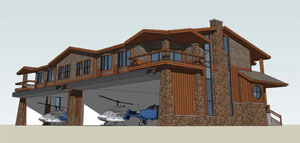
There are some people-Im guessing they are all located at upscale, privately owned airparks-who have airplanes in architectural monuments built around their planes. You know…the folks with palatial residences, with a large picture window in the living room that looks out onto a beautifully appointed hangar wherein sits their pride and joy.

A rendering of a residential hangar unit, this one at the SilverWing at Sandpoint development.
Check out the rendering on the SilverWing at Sandpoint, Idaho, residential community web site (www.silverwingatsandpoint.com) and its plan for the publicly funded airport there.
Better Homes and Gardens could devote an entire issue to these wonders of imagination and their owners love for their aircraft. These hangars are always neat and spotless, complete with epoxied floors, often emblazoned with the owners logo or design, and everything in its place.
Most of us at publicly owned airports aren’t so lucky. We must be content with lesser structures and live with restrictions on how we decorate them. The typically smaller size of these hangars also means that things are more difficult to organize. I have long surmised that just as the eyes are the window to the soul, a hangar is the window to a pilots sense of organization. My hangar is a prime example: Its like a wrecking yard, filled with several important and useful things, a wide assortment of odds and ends that cant be thrown away and some that should be discarded but haven’t been because I might need them one day. Sound familiar?
So, Whatcha Got?
Lately, what has become more important than Where did you put that drill bit? or What will the neighbors think of my oak-paneled hangar? is Whats in your hangar? This question recently became preeminent at our Bend, Oregon (KBDN), Airport when the previous airport manager asked the Bend City Council for a 3% increase in rent for the city-owned hangars. At the same meeting, she asked for guidance regarding what she referred to as non-compliant uses of the hangars. The wording in the city’s General Aviation Minimum Standards (GAMS) document says that, Storage of non-aviation vehicles or equipment or other materials shall not be permitted, even on a temporary basis, and it seems that some of the city’s hangar tenants are storing their RVs (the road type), boats, cars and other items in their hangars along with their aircraft. Apparently, there’s also one person who lives there, in an RV, in his hangar.
Coupled with the rent increase request, the non-compliant use issue caused a firestorm to erupt from the council bench, with the most frequent phrase being that, These people are taking advantage of cheap commercial storage. (Bend already has the second-highest T-hangar rents in Oregon, but that doesn’t seem to matter.) One council member proposed doubling the rent, and then tripling it, until we drive those people out. Yipes!
I wasn’t worried about my GlaStar, the D-260 biplane project or the IO-470-E engine parts in my hangar. But I was worried about my air compressor, drill press and bench grinder. Would those be banned? What about my workbench and shelves? What about the extension cords, vacuum cleaner and trash can? What about my TIG welder (that I cant use because there’s no 220-volt power in the hangar) and my engine heater? Having an assortment of items in my hangar that could be deemed non-compliant, I decided to investigate what other airports have to say about hangar uses.
A Google search of permitted uses of aircraft hangars turned up hundreds of examples of permitted uses. A few airports (like Bend) are strict in what goes into the hangars, while others are more liberal. For example, the St. George (Utah) Municipal airport prohibits …Storage of non-aeronautic equipment or materials unless approved by the Airport Manager (www.sgcity.org/airport/pdf/RulesAndRegulations9-08draft.pdf).
Thats strict, but at least it allows for some storage as long as the airport manager approves it. Another example where the airport manager rules is at the Gross Ile airport in Michigan. There, the regulations make specific allowances for storage of some non-aeronautical items: 200.16-1.1. Except as identified above, no other non-aircraft (i.e., personal, household or commercial) items may be stored in a T-hangar unless approved by the airport manager. If no plane is housed in the T-hangar, storage of above items will not be allowed (www.grosseileairport.com/rules.htm#200.16).
Almost all of the airports provide for storage of some non-aeronautical items as long as there is an aircraft housed there as well, with …the approval of the airport manager.
Interestingly, many airports have regulations that specifically permit non-commercial uses for their hangars, provided that they also store an aircraft. For example, consider the Wasco, Oregon, Airport policy: The aircraft hangar is intended to be primarily used for the storage, maintenance, and assembly of airplanes and other aviation related equipment. Additional storage of a car, boat, motorcycle or other items is allowed as long as storage of these items does not prevent the storage of an airplane (http://co.wasco.or.us/planning/WCOrd/Chapter03EPD-11.pdf).
And heres the language from the Permitted Uses and Use Restrictions portion of the Morgan County Airport (Connellsville, Ohio) Overlay Zone document: Non-Commercial Aeronautical Activity: No private aircraft owner shall be prohibited from performing, on their own equipment, those specific preventative maintenance routines as are outlined in Appendix A of FAR Part 43, whether such performance is within a privately owned hangar, or on a ramp or tie down. Private hangar owners may maintain and/or store in their hangars such non-aeronautical equipment as boats, travel/utility trailers, automobiles, etc., provided such use of that hangar is only incidental and secondary to its primary use as an aircraft maintenance and/or storage facility.
The words primarily used for the storage of aircraft and aeronautical activity are commonly found in the online documents. However, it is uncommon to find highly restrictive language such as that found in the Bend document. Note that primarily used for storage of aircraft means that the hangars can be used to store other items, and where the regulations are more narrow, almost all of the references have words that describe with the approval of the airport manager and allow customary and usual aviation-related activities.
What the FAA Says
Federal Aviation Administration regulations require that hangars at publicly owned airports be used for aeronautical activity, which is any activity that involves, makes possible, or is required for the flight or ground operation of any aircraft, or which contributes to or is required for the safety of such operation (1). It does not decree that hangars can be used to store only an aircraft and nothing else.
Your local fire marshal and environmental authorities also have a say in how you use your hangar. Unless you have the permits to do so, storage of large quantities of gasoline, pesticides, radiological or other hazardous materials is apt to get you in trouble.

Large hangar developments like this one at the Chino, California, airport are part of a growth strategy popular with outlying airports.
Residential accommodation at publicly owned hangars is a dog with different spots. In 1999 and 2002 letters to the city of Prineville, Oregon, the FAA wrote, Permanent or part-time residences-even those with, or inside of, hangars-are not an appropriate use on a publicly owned airport. And while the letters make a provision for a designated airport manager/caretaker, …residential use is considered incompatible with airport use due to noise impacts. The 2002 letter goes on to say that, While hangar tenants would presumably accept the noise and other conditions typical of an airport environment, there is the potential that on-airport living quarters, over time, may be rented or sold to non aviation-oriented persons who would not be tolerant of the situation, and who might complain (or even sue) the [airport owner] as a result.
The 2002 FAA letter also points out that, …non-essential residences [can] set a precedent which would not allow the [city] to discriminate against similar [residential proposals] in the future-potentially setting up the city as the landlord of unrestricted residential uses on airport property.
A more recent case is playing out right now in Sandpoint, Idaho. At the airport there, the FAA put the county on notice that it was cutting off funding to the airport for up to three years for allowing a residential developer perpetual through-the-fence access to the airport and for allowing midfield access (2). (For more on this topic, see Peeking Through the Fence, below.) This issue has put the developers of the SilverWing at Sandpoint residential community in a difficult situation because the development had been approved by the county. The FAAs notice may also affect operations at the Quest Aircraft Company-manufacturer of the turbine-powered Kodiak STOL airplane. Triggered by residential concerns, the FAAs position may impact jobs in the Sandpoint area-an unintended consequence of residential development.
So what do you do if your airport manager tells you to remove your air compressor or crystal chandelier from your hangar because you are taking advantage of cheap commercial storage? First, before that happens, read your lease or rental agreement and get to know your airport manager. He or she is an important person in your life, and you want that person as an ally, not an enemy. Second, get informed about what communities around your airport are doing. Personal contact and the Internet can be a big help. Be prepared and informed. Third, if your hangar agreement contains onerous or restrictive language, get your pilot groups to address the issue in an organized and united way. Make the case before your city or county officials, and try to get the allowed hangar uses at your airport broadened to cover your needs and interests. At Bend, we are working to get the permitted uses language changed. Time will tell how successful we are in that quest.
Epilogue
After this article was submitted, the city of Bend hired a new airport manager. One of his first actions was to establish the Bend Advisory Council (BAC), composed of stakeholders, to help him more quickly get his feet on the ground. Among the first issues raised by the BAC was hangar use. The developer of a hangar project at the Bend Airport that will cater to owners of bizjets and other high-end aircraft complained that several of his potential sales (and thus revenue to the city) had been thwarted because of the city’s restrictions on hangar use. The developer noted that the potential buyers had walked away from a $500K to $1M purchase because they also wanted to store their recreational vehicles and other items in the hangar. To address this economic disadvantage to the city, the BAC drafted a change to the General Aviation Minimum Standards document that replaced the words Storage of non-aviation vehicles or equipment shall not be permitted… with less restrictive language that allowed other uses of the hangar while stipulating that the primary use of a hangar is for aircraft storage.
The airport manager concurred that the proposed change to the GAMS was consistent with both FAA policy and the city’s intentions to foster growth at the airport. The revised GAMS was submitted to the city for approval. But no one knew who should sign off on the GAMS to get it approved. Uh oh. Thus began a bureaucratic bad dream that is continuing almost a year after the revised GAMS was submitted. The city staff decided that the matter was too mundane to take to the full city council, and the best way to deal with the GAMS was to treat it as an administrative change that could be approved by the city manager. But Bend did not have any policy that gave administrative change authority to the city manager (we are a little city, after all.) So a policy change document that gave the city manager the authority to approve administrative changes was prepared and sent to the city council, and it has been approved.
But then the city attorney decided that there were many such little administrative changes throughout the city that needed to be made, so all of those little changes should be bundled up into a comprehensive package that the city manager could sign off all at once. As a result, here we are, waiting for the city to put that bundle together and get it approved. In the meantime, the developer is left hanging in the wind and has lost some sales because of the uncertainty. Other more trusting buyers have agreed with the developer that the changes would eventually be approved and have gone ahead with their purchases. We, too, are confident the GAMS changes will be approved eventually. And the airport manager no longer feels the need to take draconian action against those of us who have tools and workbenches, welders and other items in our hangars as long as the primary use of a hangar is for aircraft storage. And, oh, yeah, the guy living in his hangar has been evicted.
(1) FAA AC150-5190-7, Minimum Standards for Commercial Aeronautical Activities
(2) Bonner County Daily Bee: “County seeks resolution to FAA funding flap”














